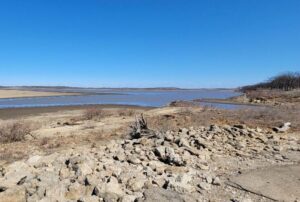Supply hits 57.1 percent; Stage 3 restrictions still in effect


Overall water supply is currently 57.1 percent, up from 56.2 percent the week before. The week of April 30, at 56.1 percent, was the lowest point since the City entered Stage 1 of the Water Shortage Ordinance in December 2022 with 71 percent available supply.
Stages of the Water Shortage Ordinance are based on the percentage of overall water supply. Stage 1 kicks in when levels fall to 79-70 percent, Stage 2 is 69-60 percent, Stage 3 is 59-50 percent, and Stage 4, which is considered “critical,” is any level below 50 percent.
“We are trending upward, and that is always good news,” said Water Utilities Director Terry Lauritsen. “Unfortunately, we haven’t received enough rainfall to pull us out of the drought conditions we are experiencing, nor have we increased overall water supply enough to pull us out of Stage 3 of the Water Shortage Ordinance.”
Emergency rates
Stage 3 restrictions limit outdoor water use to one day per week, imposes fines for violations, and includes emergency water rates for households using 2,001 or more gallons of water per month. Stage 3 rates, which will go into effect Wednesday, will affect 6,000 of the City’s 14,000 water customers, Lauritsen said.
“The average household uses about 6,600 gallons of water per month, and that household can expect to see an increase of about 88 cents per month on their bill,” he said. “A larger family that does a lot of outdoor watering might use 25,000 gallons, so that household would see an increase of about $9 per month. The emergency rates are not all that punitive but rather are intended to draw attention to the need to conserve.”
Rate increases and restricting outdoor water use have been shown to be the most effective tools for reducing consumption, Lauritsen said.
“We’ve implemented both measures and have seen consumption fall to 4.25 million gallons per day (mgd) from the previous 4.38 mgd,” he said.
Without enough measurable rainfall to change the picture, the City is projected to move to Stage 4 of the Water Shortage Ordinance in June and could run out of water as early as January 2024.
“Without rain and/or major reduction in consumption between now and then, we are targeted to be at roughly 15 percent in overall supply by January 2024,” Lauritsen said. “This is about where we were during the drought of 2001-02, so this would be a very serious situation for us.”
Lauritsen said modifications to the Water Shortage Ordinance could be considered if conditions continue to worsen.
Past and future
The City has taken several measures since the drought of 2001-02 to ensure more access to available water now and in the future.
“As a result of a study done in 2008 and information that has come to light since, in 2020, the City purchased the remaining storage rights at Copan Lake — 2,500 acre feet, or 1 million gallons a day — which took a federal act of Congress and more than 12 years of work through the legislative process to keep the cost affordable for our customers,” Lauritsen said. “The City is also implementing water reuse, which takes treated wastewater and pumps it upstream of the City’s raw water intake on the Caney River, where we can recapture and send it to the water plant for further treatment.”
He said reallocation of Copan and Hulah will be pursued in the future, but reuse was prioritized over reallocation because water reuse is not impacted by drought or other environmental factors that can affect water availability at Hulah or Copan lakes. The resuse system itself is nearly complete. However, the City is years out from completing the regulatory process required to use it, Lauritsen said.
“All of these processes take time — years, in fact — to implement, so a quick fix is not on the horizon,” he said. “Hopefully, we’ll receive significant enough rainfall next month to replenish the lakes and pull us out of this situation. But right now, conservation is the best and most viable tool we have.”
For more information, see the following:
Q&A: Emergency rates & other water questions
Water supply shows slight improvement
Restrictions continue, Stage 3 rates in effect
What to do
The following provisions are in effect for all City of Bartlesville water customers:
- Rates increases for customers using more than 2,000 gallons of water per month.
- 2,001 gallons to 10,000 gallons – 5 percent increase
- 10,001 gallons to 25,000 gallons – 10 percent increase
- 25,001 to 50,000 gallons — 15 percent increase
- In excess of 50,000 gallons – 20 percent increase
- Outdoor water is restricted to one day per week (Violations could result in a fine of $50 for the first offense up to $500 for the fifth or more offense)
- Even-numbered properties may water on Thursdays
- Odd-numbered properties may water on Friday
- Water pressure is being reduced within the distribution system to minimum levels allowed by state and federal regulations
To see the full list, see www.cityofbartlesville.org or Water Shortage Ordinance.
Note: A variance committee is in place to consider cases of undue hardship for the emergency rates only and does not apply to outdoor water use. To apply for a variance, complete the “Contact Us” form on the City’s website, www.cityofbartlesville.org, or call 918.338.4100.
